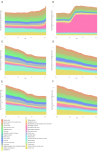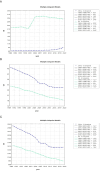Comparative study of early onset cancer burden between China and the United States from 1990 to 2021
- PMID: 40764701
- PMCID: PMC12325976
- DOI: 10.1038/s41598-025-10185-w
Comparative study of early onset cancer burden between China and the United States from 1990 to 2021
Abstract
China and the United States face a mounting burden associated with early-onset cancers. Comparing the burden and trends of early-onset cancers between the two countries, analyzing attributable risk factors, drawing on the successful experience of the US in cancer research, prevention, and care can provide valuable insights to inform China's prevention and control strategies. A comparative study based on the 2021 Global Burden of Disease repository was conducted to assess the average annual percentage change in the burden of early-onset cancers. Linear regression analysis was performed using the JoinPoint model. The metrics analyzed included the incidence, mortality, disability-adjusted life years (DALYs), and attributable risk factors related to early-onset cancers. In 2021, the number of new early-onset cancer cases was 750,600 in China and 472,600 in the US, with deaths totaling 240,800 and 30,600, respectively. The age-standardized incidence rate (ASIR) in the US was higher than in China, while its age-standardized mortality rate (ASMR) and DALYs were lower. The ASMR declined annually by 1.57% in China and 1.65% in the US, and the age-standardized DALYs rate decreased by 1.50% and 1.71% per year, respectively. Breast cancer, non-melanoma skin cancer, and colorectal cancer were the cancer with the highest ASIR in both countries. Smoking, high fasting plasma glucose, and dietary risks were primary contributors to DALYs losses across various early-onset cancers. Both nations need to adopt preventive and control strategies tailored to young populations, guided by the burden trends of early-onset cancers, to mitigate their social and economic consequences.
Keywords: Burden of disease; Disability-adjusted life years; Early-onset cancer; Epidemiology; Public health; Risk factors; Temporal trend.
© 2025. The Author(s).
Conflict of interest statement
Declarations. Competing interests: The authors declare no competing interests.
Figures






Similar articles
-
National and subnational burden of brain and central nervous system cancers in China and global from 1990 to 2021: results from the global burden of disease study 2021.Arch Public Health. 2025 Jul 28;83(1):195. doi: 10.1186/s13690-025-01683-4. Arch Public Health. 2025. PMID: 40722045 Free PMC article.
-
Incidence and disability-adjusted life-years of infective endocarditis in China from 1990 to 2021: comparison with G20 based on the Global Burden of Disease Study 2021.BMJ Open. 2025 Jul 6;15(7):e094490. doi: 10.1136/bmjopen-2024-094490. BMJ Open. 2025. PMID: 40623737 Free PMC article.
-
The comparative burden of brain and central nervous system cancers from 1990 to 2021 between China, the United States, the United Kingdom, and Japan.BMC Public Health. 2025 Aug 6;25(1):2670. doi: 10.1186/s12889-025-23982-9. BMC Public Health. 2025. PMID: 40770698 Free PMC article.
-
Trends and projections of the burden of gastric cancer in China and G20 countries: a comparative study based on the global burden of disease database 2021.Int J Surg. 2025 Jul 1;111(7):4854-4865. doi: 10.1097/JS9.0000000000002464. Epub 2025 May 12. Int J Surg. 2025. PMID: 40359560
-
Global burden and risk factors of musculoskeletal disorders among adolescents and young adults in 204 countries and territories, 1990-2019.Autoimmun Rev. 2023 Aug;22(8):103361. doi: 10.1016/j.autrev.2023.103361. Epub 2023 May 23. Autoimmun Rev. 2023. PMID: 37230312 Review.
References
-
- GBD 2017 Causes of Death Collaborators. Global, regional, and national age-sex-specific mortality for 282 causes of death in 195 countries and territories, 1980–2017: A systematic analysis for the Global Burden of Disease Study 2017. Lancet392, 1736–88 (2018). 10.1016/S0140-6736(18)32203-7 - PMC - PubMed
-
- Mooney-Somers, J., Lewis, P. & Kerridge, I. Discursive constructions of youth cancer: findings from creative methods research with healthy young people. J. Cancer Surviv. 10, 427–436. 10.1007/s11764-015-0488-1 (2016). - PubMed
-
- Miller, K. D. et al. Cancer statistics for adolescents and young adults, 2020. CA Cancer J. Clin.70, 443–459. 10.3322/caac.21637 (2020). - PubMed
Publication types
MeSH terms
Grants and funding
LinkOut - more resources
Full Text Sources
Medical

